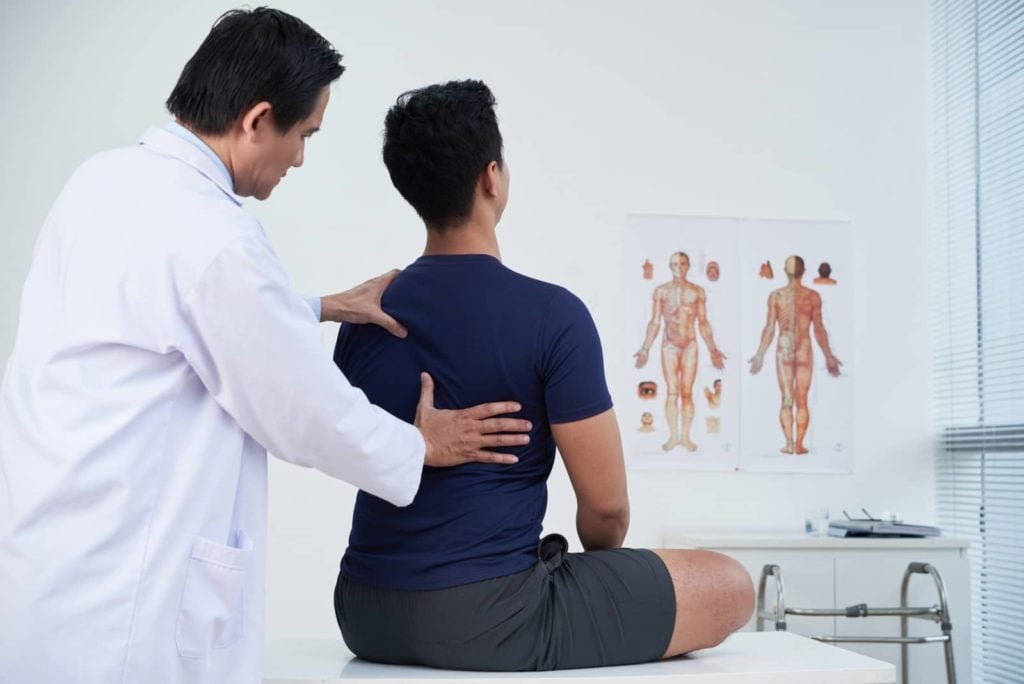Serious job injuries are a human tragedy. All too often there is no good solution for significant injuries. When an injury is severe enough, the injured person may never recover from the unrelenting pain and permanent disability. In these situations, the Department of Labor and Industries (L&I) will attempt to pound the final nail in the coffin, using an Independent Medical Examination (IME), to end the injured worker’s claim. It’s up to the injured worker to stand up for themselves and fight back against this unfair tactic.
At Sharpe Law Firm, we stand by injured workers and help them overcome the ruthless trickery of L&I and their “independent” medical examiners. We never represent the employer or insurance company. If you’ve suffered a tragic workplace injury and you’re tired of fighting for the compensation you deserve, schedule a free case evaluation today to learn how we can help you fight these injustices.
The Truth About Independent Medical Examination (IME)
The stated purpose of an Independent Medical Examination (IME) is to obtain a medical evaluation to determine the status of a worker’s medical condition. However, the true purpose of an IME is to use that determination to end or limit your L&I claim. L&I has a plan for you, and they will use the IME to make it happen. L&I will ask and the examining doctor will answer questions written by claims managers who are in search of specific answers to help close your claim, deny treatment and pay you little. These questions look like this:
- Is any further medical treatment necessary?
- Has the worker’s claim-related medical condition reached maximum medical improvement?
- Are there work restrictions?
- Is there any permanent impairment?
The truth is IMEs are a complete sham that claims managers use to deny medical treatment and close claims. They are not independent and are not medical exams. They are a bought and paid-for one-sided records review designed and administered to ruin your L&I claim.
Who Are These Independent Medical Exam Doctors?
These doctors are bought and paid for by L&I and Self-Insureds and have long ago sold out to the establishment. Very few of them are active medical professionals. Many make hundreds of thousands of dollars per year by sticking it to injured workers. Their opinions are heavily biased, and many already believe you aren’t injured before they even begin your examination. Their primary purpose is to write a favorable report that allows L&I to end your claim without paying you the compensation you deserve.
Why Is an Independent Medical Exam Being Scheduled?
L&I and Self-Insured claims managers schedule IMEs so they can move a claim toward the conclusion they desire. To do so, IME exams are scheduled with doctors who will help them “manage” a claim. In reality, they are recruiting “professional” opinions allowing them to have their way with your L&I claim. The rules about scheduling and performing an IME are under RCW. 51.36.070. Claims managers ask for an IME because they want to:
- Gather information
- Determine maximum medical improvement
- Segregate out medical conditions
- Deny medical conditions
- End medical care
- Rate your disability and
- Close your claim

Who Requests Independent Medical Exams?
People in charge of your claim can request an IME and follow-up IMEs. Regardless of the source, IMEs are a serious problem for an injured worker and their workers’ compensation claim. The following entities may request an IME:
- Labor & Industries. (this is a problem)
- Self-Insured employers. (this is a problem)
- Your doctor (this could be a problem)
- The Board of Industrial Insurance Appeals
When Can Independent Medical Exams be Requested?
An independent medical evaluation can be requested for various reasons, RCW 51.36.070 (1) Medical examination including:
- To make a decision regarding claim allowance or reopening.
- To resolve a new medical issue, after the filing of an appeal, or to assess case progress.
- To evaluate a worker’s permanent disability, work restriction, or ability to work
- Policy 13.05 An IME can only be requested for specific reasons.
- Policy 13.07 What happens if a worker cancels or fails to appear for an IME
There are specialized rules about IMEs in the Washington State statutes that an injured worker or their workers’ compensation attorney should pay attention to. The following statutes outline important IME rules:
- RCW 51.32.110 explains the requirement to attend an exam, pay travel expenses, and pay for time lost from work while at the IME
- RCW 51.36.070 (1)(a) explains where an IME can be scheduled and establishes telemedicine as an option for an IME if a physical place is not reasonably convenient, see also RCW 51.36.072 and RCW.51.36.070 (1)(b)
- RCW 51.08.121 defines “new medical issue.” See also WAC 296-23-302, and WAC 296-23-308
- The number of IME’s is limited by statute and WAC 296-23-309
Can I Record My IME?
You may record your independent medical examination using audio, video, or both. Here is some information to keep in mind should you elect to record your examination:
- You or your representative must provide notice to the IME provider that you intend to record the examination no less than seven calendar days prior to the examination.
- You can record the IME. You may not hold the recording equipment while the examination is occurring. (Note: If you’re going to use your mobile phone, you must select record and then set it down).
- An observer can record an IME. You must take reasonable steps to ensure the recording equipment does not interfere with the examination.
- You may not post the recording to social media.
- More important information about recording: RCW 51.36.070 (4)
If you don’t like what L&I is doing to you, you must do something about it
As with most personal injury claims, work injury claimants must defend themselves throughout the entire claim process. L&I and Self-Insured employers are not interested in treating injured workers fairly. Nothing personal – for them you are just a claim number. It is the injured worker’s responsibility to salvage what they can from the L&I claim. Let me shout this:
IT IS THE RESPONSIBILITY OF THE INJURED WORKER TO SALVAGE WHAT THEY CAN FROM THE L&I CLAIM.
Do not confuse politeness with your job to take care of yourself. If you don’t help yourself, who will? If you can’t help yourself, contact a lawyer to see if they will help you. You only get a short period of time after your IME to salvage what you can from your L&I claim. Do it or lose it!
What Can I Do About a Bad IME?
If you don’t like what shows up in your IME report, there are steps you can take to counteract that bad IME.
First and foremost. Your attending physician will be asked by L&I to agree with the IME. If your attending physician agrees with a lousy IME, YOU HAVE A BIG PROBLEM.
However, if your attending physician disagrees with a bad IME, there is still hope for your claim.
TALK WITH YOUR DOCTOR BEFORE THEY AGREE WITH A BAD IME! Get your doctor to write a helpful report outlining their disagreement with the incorrect IME findings and conclusions, in that report your doctor should include their own findings and conclusions.
It will make a difference.

Can I Dispute That an IME Should be Scheduled?
RCW 51.36.070. You can dispute the scheduling of an IME, both before and after the IME. The number, frequency, timing, and reason for IMEs can be questioned through the dispute process. Additionally, a work injury claimant should be given the required 28 days’ notice of the IME, except for IMEs to address claim allowance, which requires 14 days notice.
The following rules and administrative codes outline your right to dispute an IME:
- WAC 296-15-440 details what L&I will and should consider when resolving a dispute to a scheduled IME.
- WAC 296-23-308 establishes thresholds that must be met for a case progress IME to be appropriate:
- The case progress IME must occur at least 120 days after receipt of the claim or the last case progress IME.
- The 120-day requirement is waived for consultations and requests of the attending provider or if so, requested by the worker.
- WAC 296-23-309 establishes criteria for the total number of examinations per claim.
- WAC 296-23-401 states that L&I can reassume jurisdiction of a claim following receipt of an appeal and direct a self-insured employer to schedule an IME.
- Want a DIY dispute to the scheduling of an IME? IME Disputes per L&I
How to Complain About My IME
Understand this about an IME complaint. It is unlikely to help your case. To help your case reread “What Can I Do About a Bad IME” above. If you still want to complain you can report a doctor who has been improper. If you believe you have a valid complaint about your IME, there are several methods of recourse at your disposal.
Minor Complaints
Minor complaints, such as rudeness, can be handled by sending an IME comment form to L&I at the following address:
IME Provider Review – L&I
PO Box 44322
Olympia, WA 98504-4322
Serious Violations
For serious violations of State Law RCW 18.130.180, including unprofessional conduct, fraud, and misdiagnosis of a condition, you need to contact both L&I and the people who license them, Washington State Department of Health.
L&I
Washington State Department of Health
- Physician Complaint Form
- Nurse Complaint Form
- Health Facility Complaint Process
- Department of Health FAQ regarding Medical Complaints

Understanding The Independent Medical Examination Process Before You Go
The IME process is riddled with tricks and traps designed to ruin your claim. When L&I requests an IME, it is extremely important for the injured worker to arrive alert and prepared for the examination.
Be Prepared When you Attend Your IME:
- Bring in an observer – This can be anyone not your legal team. RCW 51.36.070 (4)(i)
- Record the IME – The worker has the right to record the IME. The rules about recording are in RCW 51.36.070 (4)
- Understand what the IME is for – The purpose of the examination will vary with your situation. IMEs are used to shut down your medical treatment, deny medical conditions, end time loss, declare that you can work, and to minimize your settlement.
- An IME doctor is not your doctor– The evaluation does not create a doctor patient-relationship. The IME doctor will not prescribe medication, will not treat you, and is not there to help.
- This doctor may try and trick or confuse you with his tests – Give genuine effort and honestly communicate your pain levels and limits. Do not exaggerate your pain levels. The IME doctor would love to observe you exaggerate so he can put it in his report. Don’t let that happen.
- What to wear – Avoid clothing that restricts movement. Avoid clothing and accessories that can convey negative non-verbal messages.
- Know about your treatment plan – Be knowledgeable about your physicians and your medical care. Make a list of medication you are currently taking along with the regimens and home therapy programs you are completing. You will be asked questions about your medical treatment.
- Limit medication before the exam – With your doctor’s permission, avoid taking medication that would cause drowsiness, limit your ability to focus, reduce inflammation, or mask pain. You want the examining doctor to naturally see your pain and swelling without you needing to prove it to them.
- Your medical records will be a big part of the IME – Know what is in them if you can.
- Don’t volunteer information – Answer the questions asked truthfully but don’t offer additional information or opinions. Likewise, don’t overly compliment the doctor.
- Don’t be offended by the doctor’s questions unless they are totally inappropriate – It’s their job to get personal about your injury.
What Happens at the Examination?
- IME physicians spend lots of time with your medical records and only a little time examining you. They have little interest in seeing your problems.
- The physicians will take your medical and family history, ask about current symptoms, and perform a short physical examination with testing. Rarely do they request x-rays or lab tests. They will write a report for L&I or the self-insured employer with their findings and opinions.
- The doctor performs a one-time exam and should focus only on industrially related conditions. These physicians are not your attending provider! These doctors are paid by L&I and self-insureds to produce a report with results that please L&I or the self-insured. These examinations are not designed to assist injured workers with their workers’ compensation claims! Be careful!
- Some IME offices watch you from the minute you leave your car until you return to your car and drive away. It is not uncommon to see IME reports saying, “He ran from his car to the office but began to limp when he entered the exam room.” Don’t allow something like that to happen to you.
- Independent Medical Examination doctors can be tricky, so keep the following in mind:
- A light touch to any area should not hurt. The doctor will report you as a faker if you act as if it hurts.
- Do not exaggerate your injuries. Many IME physicians want you to embellish your injuries so they can say that in their report.
- The distraction test involves pretending to test one area while recreating a previous test in a different area. For example, if the doctor is testing your neck, he might do so obviously in front of you. Later he might test it via distraction by asking questions while he walks behind you. He is looking to see how you rotate your neck when you don’t realize your neck is being tested.
- Dropping an object such as a pen on the floor is done to see if you will either pick it up or look at it quickly and thereby make movements you might not have made while you think you are being tested.

What Happens After an IME?
Your claim will change after an Independent Medical Examination.
- The exam is converted into a report. That report is now also called the IME.
- The IME goes to L&I or the Self-Insureds.
- They usually send a copy to your doctor with a cover letter asking them to agree or disagree with the IME report. For example:
- Doctor, if you agree, initial here ____ (This takes your doctor 5 seconds.)
- Doctor, if you disagree, write a lengthy report. (This could take an hour.)
Therein lies the problem. Your doctor can initial in 5 seconds and be done with it OR your doctor can spend an hour or more writing a report about their own findings and how the IME doctor is wrong.
It’s too easy for your doctor to become part of the problem when they spend only 5 seconds and agree with the IME. Then, L&I or the Self Insurer will take the IME and your doctor’s concurrence and move your claim toward the IMEs conclusions.
For example, if your doctor agrees with the IME that says you are “fixed and stable” then L&I will conclude your medical treatment is done and they will begin to close the claim. Soon thereafter an order will be issued by L&I or a self-insured employer, closing the claim.
Don’t let this happen to your claim. You must talk to your doctor and have them help you. See “What Can I Do About a Bad IME” above.
You have 60 days from receipt of any L&I order to protest or appeal the L&I Decision.
Settlement After an IME
An IME often begins the process of claim closure, at which point, L&I will often address the subject of claim settlement. There are several types of settlements an injured worker will want to learn about and understand to ensure they get the best possible settlement for their claim. Learn about settlements and closure of your L&I claim: How to Settle a Washington State L&I Claim
We Understand That IMEs Are Serious Business
IMEs are designed to end your time loss & medical care and close your claim with no settlement or less settlement money than you deserve. Are you going to let them do this to you? Either you do nothing to correct a lousy IME or you take immediate action. It’s not complicated. It is your choice. I suggest you do something to help yourself.
My name is Chris Sharpe. I’m an experienced Seattle workers’ compensation attorney who has helped thousands of injured Washington State workers. Can we be of assistance to you? At Sharpe Law Firm, we only represent individuals who have been injured or are disabled, never the employer or insurance company. Contact us today to schedule a complimentary and free case evaluation and learn how we can help you.

Frequently Asked Questions
Yes, you can. If IME doctors tell you differently, they are wrong. Here are the details:
– An observer can be anyone at least 18 years old who is not your attorney, paralegal, or doctor.
– The observer can attend the physical examination but not the psychiatric assessment as per WAC 296-20-2025.
– This observer can see and take note of anything the IME doctors do which may not be appropriate.
– They can also track how much time was spent examining you versus how much time was spent reading your health records.
– An observer can help keep the IME doctor honest. It’s a good idea to bring someone along.
– An observer can record an IME. This can be very helpful.
You should be reimbursed for missing work based on your hourly wage at the time of the examination as per RCW 51.32.110 (4). Talk to your claims manager to make this happen.
In certain situations, there is reimbursement for meals, hotel expenses, taxi fare, parking costs, and ferry and bridge tolls. RCW 51.32.110 (3), WAC 296-20-1103, and L&I Claim Adjudication Guidelines. These will be paid at the current department rate. Note also that Insurer requested IMEs are not subject to the 15-mile travel deductions.
SAVE YOUR RECEIPTS!!! You must complete a travel reimbursement form within one year of the exam and include your receipts.
Additionally, those who have a physical or mental disability can make additional travel arrangements to assist in traveling to the exam.
Contact your claims adjuster immediately and request a different date. Reasonable requests should be accommodated.












